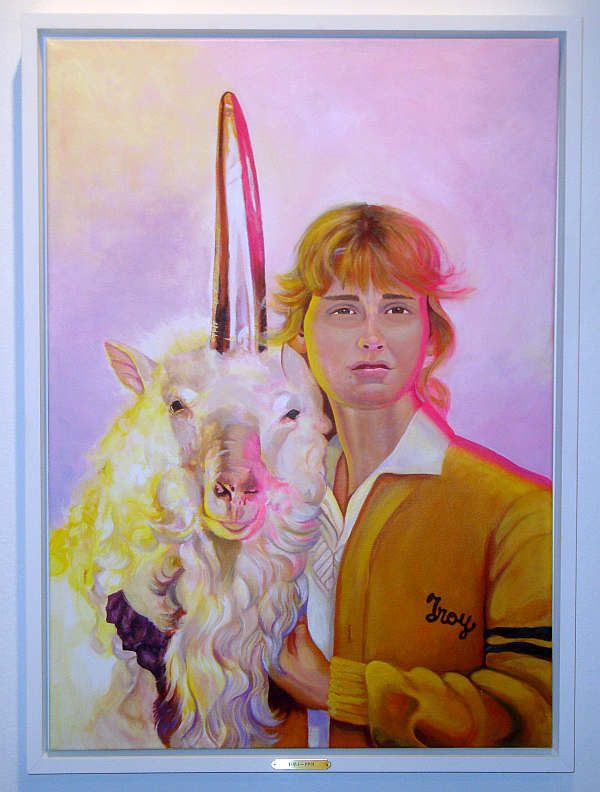
Cheyanne Ramos for Sebastian Forray, Seven Years Bad Luck, pt. 2 (Kerri Green and the Living Unicorn), 2012, acrylic on canvas
The weirdest part of the UH MFA thesis show was a little sub-show by Sebastian Forray called Seven Years Bad Luck. I didn't understand it, but I loved it. But I was troubled by my lack of analytical ability. I'm an art critic, dammit! I should be able to create an explanation for any art I see, even if I have to make something up whole cloth. So I broke down and asked Sebastian Forray about the show. I'm still not sure if I understand it, but at least some questions have been answered.
First of all, the show consists of five paintings and the contents of a vitrine. The paintings are numbered, and none of them are painted by Forray. They all have titles like Seven Years Bad Luck, pt. 2 (Kerri Green and the Living Unicorn). According to Forray, "Some are straight commissions, others are collaborative, and one was made with almost no input from myself."
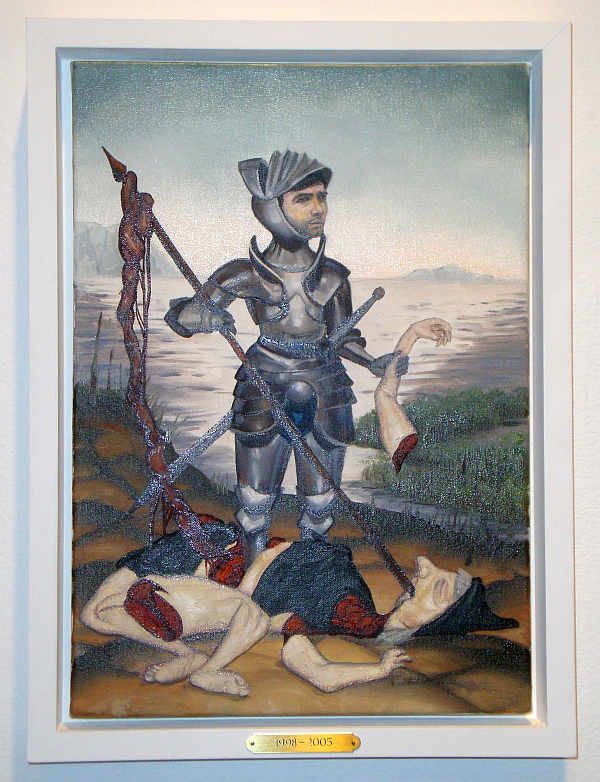
Seth Alverson for Sebastian Forray, Seven Years Bad Luck, pt. 4 (The Slaying of the Blair Witch), 2012, oil on canvas
His collaborators/hired guns include some of the best-known young artists in Houston. And generally they are painters (one piece is mixed media) who exhibit a high level of craft in their own work. Seth Alverson and Cheyanne Ramos are virtuosos in their own paintings. I'd say they held back a bit for these paintings. Ramos in particular seems to have deliberately given her painting of Goonies star Kerri Green a "thrift store painting" awkwardness (that hot pink "glow" on the right of the figure, for example), and the same could be said of Seth Alverson's The Slaying of the Blair Witch. The fact that both these highly skilled painters did work that feels somewhat awkward and amateurish makes me think that this was a request on the part of Forray.
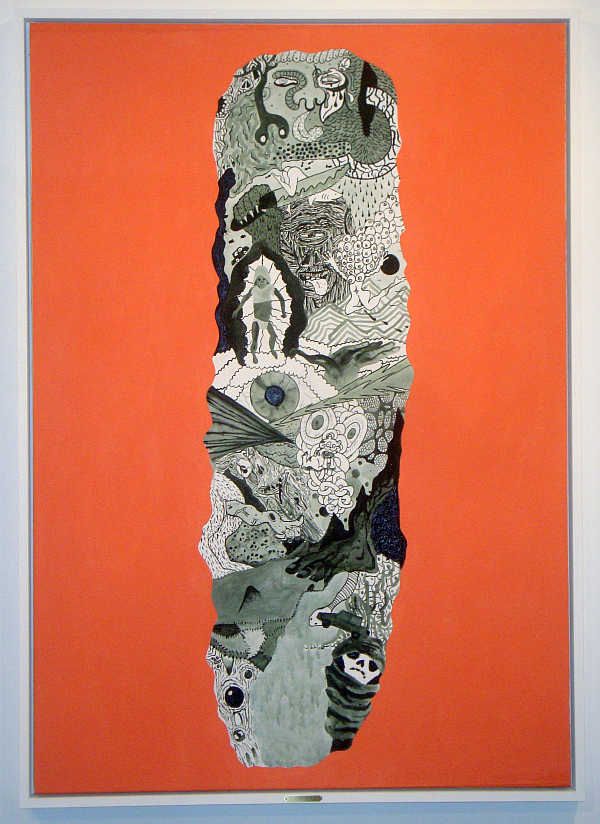
Emily Halbardier for Sebastian Forray, Seven Years Bad Luck, pt. 3 (Fresh Loaf '92 in Hooker's Green), 2012, oil on canvas
Emily Halbardier's work, by contrast, has been described as coming across "as under-skilled or shallow in its processes," but as an artistic strategy. "Deskilling" in other words. And we see this in Fresh Loaf '92 in Hooker's Green, but I think we also may be seeing a deliberate attempt to create an artwork as if it were created by another person--in this case, a teenage boy. The fantasy motifs, the raised knife, the cartoonish sexualized female figures (including one with approximately 46 boobs), the scatology, etc., all seem like the creations of another persona. (This strategy reminds me a bit of Jim Shaw's work. Coincidentally, Shaw has also long been interested in thrift store paintings.)
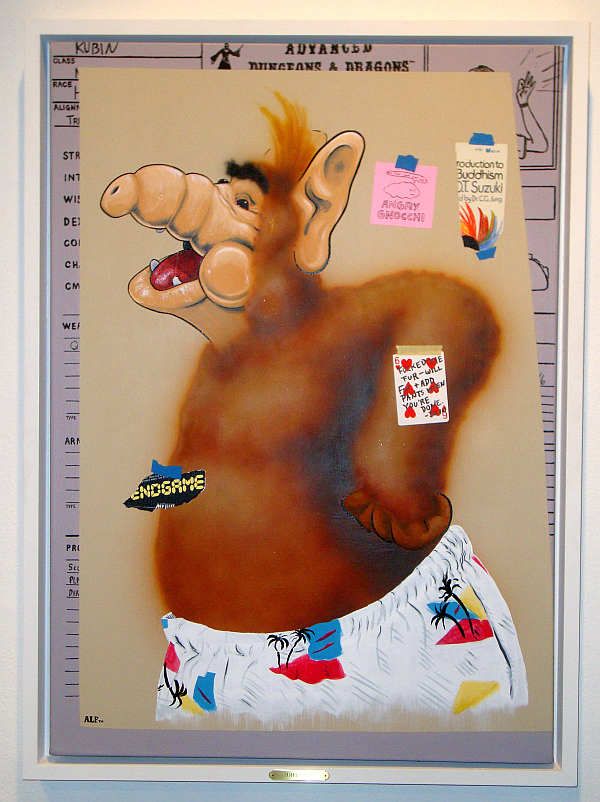
Graustark Gang for Sebastian Forray, Seven Years Bad Luck, pt. 5 (A Painting by the Graustark Gang), 2012, acrylic on canvas
Does A Painting by the Graustark Gang fit in with my "fake thrift store paintings" theory. I would say yes because all paintings of Alf are by definition thrift store paintings. But who are the Graustark Gang? They are Jessica Ninci, John Forse, Sam Ackerman and Michael Harwell. I liked the notes "taped" (painted) to the image.
The last piece (pt. 1, if you're keeping track) is by Cody Ledvina. It's the only non-painting.
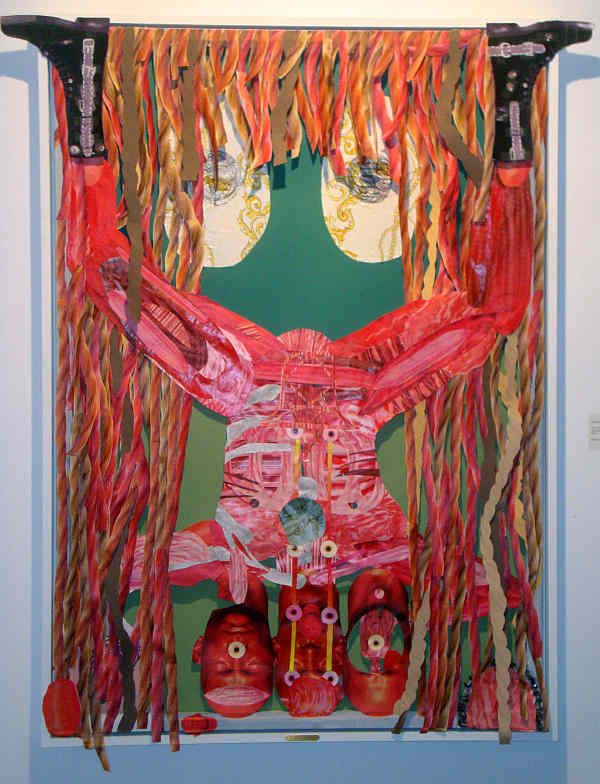
Cody Ledvina for Sebastian Forray, Seven Years Bad Luck, pt. 1 (Life with Four Hundred Thirty Two i's), 2012, mixed media on panel
Life with Four Hundred Thirty Two i's really kind of screws up my thrift store painting theory. First of all, it's not a painting, and in my experience, thrift store art tends to be paintings. They may have absolutely bizarre imaginations, but thrift store artists seem to be quite conservative when it comes to materials. In any case, the whole thrift store painting idea wasn't really going anywhere, anyway. Maybe I should defer to Forray instead of trying to think up ideas about this art on my own.
So I asked him, what do parts 1 to 5 represent? He replied, "Each one represents a seven year section of my life (which began in 1977). There are plaques on each painting identifying the years. I am turning 35 this year, so I split my life into five seven year sections, each contributor got one section to make a painting for. Again, depending on who it was and what they wanted, I provided brief or detailed biographical information (or instructions), but also encouraged the other artists to incorporate their own memories/details from the same seven-year period." Damn, that was simple. So Ledvina's piece represents a period in either Forray or Ledvina's life when one of them was a red, three-headed man. Seven Years Bad Luck, pt. 2 (Kerri Green and the Living Unicorn) represents the years 1985 to 1992, and The Goonies came out in 1985. Maybe Forray had a crush on Kerri Green. Halbardier's part 3, with its teenage boy imagery, happens to coincide with Forray from age 15 to 21, so that fits. Part 4 covers the years 1999 to 2006, and The Blair Witch Project came out in 1999. But what Alf has to do with Forray's late 20s and early 30s--well, that one I don't get. But that's OK. The point isn't to puzzle these paintings out.
But I did wonder about the lack of art from the artist himself. Was this some kind of arch conceptual statement about authorship? But the answer is simpler and more straightforward. "Painting grads have to produce two shows during their graduating semester. One in the small projects gallery, and one for the MFA show. I did all my own work for the small project gallery where I defended my thesis. Curating is also part of what I do so I decided to base the MFA show on this aspect of my 'practice.'" As a curator, Forray is being highly interventionist. I mean, the usual conception of a curator involves a degree of deference to the art. Not here--he is the ringmaster, the architect, and the show is about him.
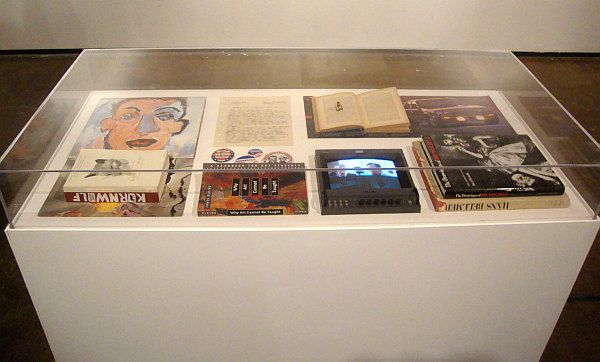
Sebastian Forray, The Vitrine of Ancillary Failures, 2012, vinyl records, books, buttons, brochure and television monitor in a display case
Hence this display case and its various mopey, dyspeptic objects. "The Vitrine of Ancillary Failures is a collection of failures, missteps, underdogs/antagonists that have caused an impact on me in some way," Forray writes.
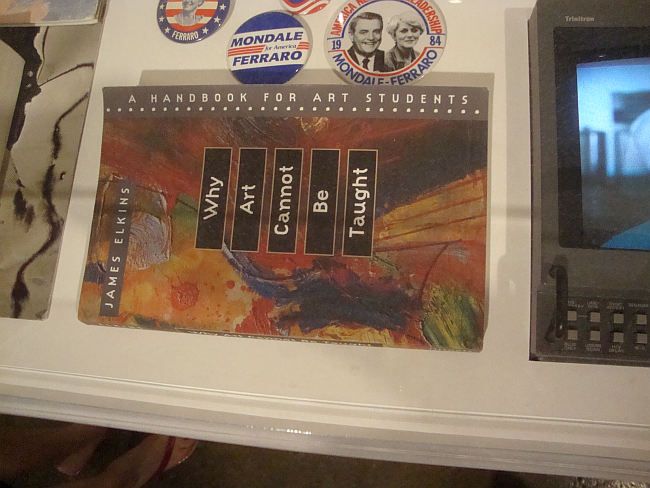
Sebastian Forray, The Vitrine of Ancillary Failures detail, 2012, vinyl records, books, buttons, brochure and television monitor in a display case
So we have this James Elkins book, Why Art Cannot Be Taught: A Handbook for Art Students, that calls into question the whole project of teaching art in a college setting, next to campaign buttons from the disastrous Modale-Ferraro 1984 presidential run. We have Self-Portrait by Bob Dylan, widely considered one of his all-time worst records. And we have a copy of Studies in Pessimism by by Arthur Schopenhauer.

Sebastian Forray, The Vitrine of Ancillary Failures detail, 2012, vinyl records, books, buttons, brochure and television monitor in a display case
All in all, the vitrine is almost a caricature of student disillusionment. It's over-the-top, and its presence in a MFA thesis show is humorous. There is something inherently optimistic about a show like this. A bunch of students are about to graduate, after all. And this is their best work, the product of two years of studying.And here's Debbie Downer with a vitrine full of bad vibes. What could be be more perfect?




MFA programs should be abolished.
ReplyDeleteWTF EARL!!!!!!!!!!!!?
ReplyDeleteAll of these... uh... paintings pretty much suck, real bad. Really badly. Wait... no. They're really good at sucking really badly. No. They suck real good. No... They just suck, ok?
ReplyDelete